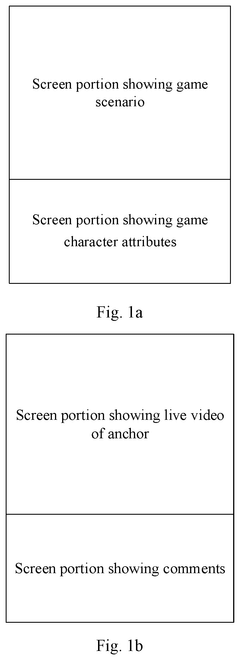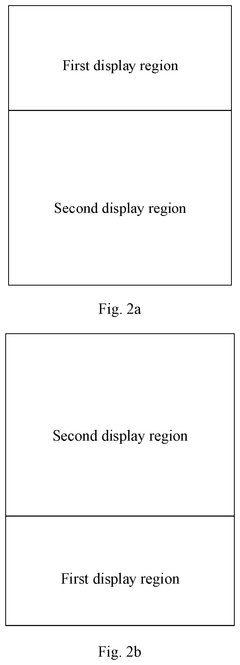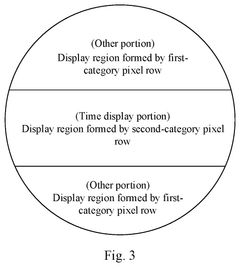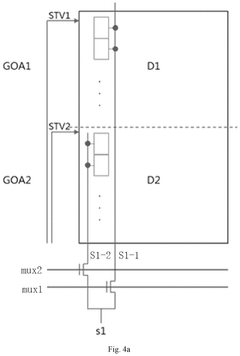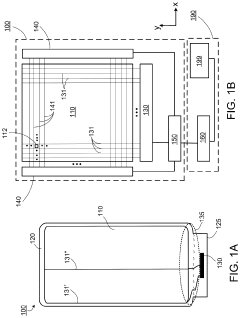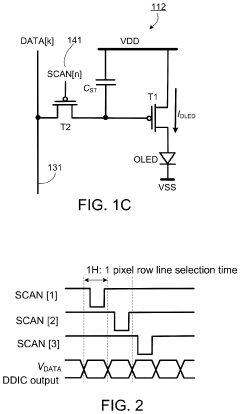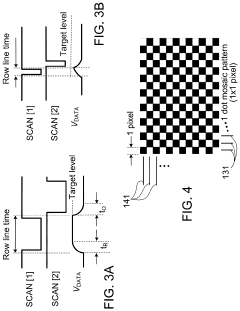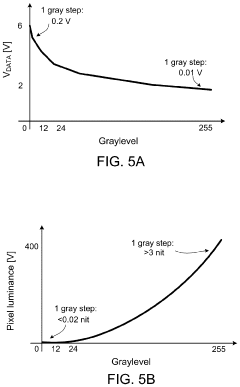Innovations in variable refresh rate designs for AMOLED displays.
JUL 17, 20258 MIN READ
Generate Your Research Report Instantly with AI Agent
Patsnap Eureka helps you evaluate technical feasibility & market potential.
AMOLED VRR Background
AMOLED (Active-Matrix Organic Light-Emitting Diode) displays have revolutionized the mobile device industry with their superior image quality, energy efficiency, and flexibility. As display technology continues to evolve, the demand for smoother and more responsive visual experiences has led to the development of variable refresh rate (VRR) technology for AMOLED displays.
Variable refresh rate technology allows displays to dynamically adjust their refresh rates based on the content being displayed. This adaptive approach offers significant advantages over fixed refresh rate displays, including improved power efficiency, reduced motion blur, and enhanced visual quality across various use cases.
The concept of VRR in AMOLED displays emerged from the need to address the limitations of traditional fixed refresh rate screens. Fixed refresh rates often result in visual artifacts such as screen tearing and stuttering, particularly in fast-paced content like gaming or video playback. Additionally, maintaining a high refresh rate constantly, even when displaying static content, leads to unnecessary power consumption.
Early implementations of VRR technology in AMOLED displays focused on switching between a limited number of predefined refresh rates. However, recent innovations have pushed towards more granular and dynamic refresh rate adjustments, allowing for smoother transitions and better optimization across a wider range of content types.
The development of VRR for AMOLED displays has been driven by several key factors. First, the increasing popularity of high-refresh-rate displays in smartphones and tablets has created a demand for more efficient power management solutions. Second, the growing mobile gaming market has necessitated display technologies that can deliver smooth, responsive gameplay experiences while maintaining battery life.
Furthermore, the unique characteristics of AMOLED technology, such as per-pixel lighting and fast response times, make it particularly well-suited for implementing VRR solutions. These inherent advantages have allowed display manufacturers to explore innovative approaches to refresh rate management that were not feasible with traditional LCD technology.
As VRR technology for AMOLED displays continues to mature, it is becoming an increasingly important feature in high-end mobile devices and is expected to become more prevalent in mid-range products as well. The ongoing research and development in this area aim to further refine VRR implementations, expanding the range of supported refresh rates and improving the algorithms that govern refresh rate transitions.
Variable refresh rate technology allows displays to dynamically adjust their refresh rates based on the content being displayed. This adaptive approach offers significant advantages over fixed refresh rate displays, including improved power efficiency, reduced motion blur, and enhanced visual quality across various use cases.
The concept of VRR in AMOLED displays emerged from the need to address the limitations of traditional fixed refresh rate screens. Fixed refresh rates often result in visual artifacts such as screen tearing and stuttering, particularly in fast-paced content like gaming or video playback. Additionally, maintaining a high refresh rate constantly, even when displaying static content, leads to unnecessary power consumption.
Early implementations of VRR technology in AMOLED displays focused on switching between a limited number of predefined refresh rates. However, recent innovations have pushed towards more granular and dynamic refresh rate adjustments, allowing for smoother transitions and better optimization across a wider range of content types.
The development of VRR for AMOLED displays has been driven by several key factors. First, the increasing popularity of high-refresh-rate displays in smartphones and tablets has created a demand for more efficient power management solutions. Second, the growing mobile gaming market has necessitated display technologies that can deliver smooth, responsive gameplay experiences while maintaining battery life.
Furthermore, the unique characteristics of AMOLED technology, such as per-pixel lighting and fast response times, make it particularly well-suited for implementing VRR solutions. These inherent advantages have allowed display manufacturers to explore innovative approaches to refresh rate management that were not feasible with traditional LCD technology.
As VRR technology for AMOLED displays continues to mature, it is becoming an increasingly important feature in high-end mobile devices and is expected to become more prevalent in mid-range products as well. The ongoing research and development in this area aim to further refine VRR implementations, expanding the range of supported refresh rates and improving the algorithms that govern refresh rate transitions.
Market Demand Analysis
The market demand for variable refresh rate (VRR) designs in AMOLED displays has been experiencing significant growth, driven by the increasing adoption of high-end smartphones, tablets, and other mobile devices. As consumers seek more immersive and responsive visual experiences, manufacturers are compelled to integrate advanced display technologies that can deliver smoother motion, reduced power consumption, and improved overall user experience.
The smartphone market, in particular, has been a key driver for VRR AMOLED displays. With the proliferation of mobile gaming and high-quality video streaming services, users are demanding displays that can adapt to different content types seamlessly. This has led to a surge in demand for devices equipped with VRR capabilities, as they can dynamically adjust refresh rates to match the content being displayed, resulting in smoother animations and reduced battery drain.
Beyond smartphones, the demand for VRR AMOLED displays is expanding into other consumer electronics segments. Tablets, laptops, and even smart wearables are increasingly incorporating this technology to enhance user experience and differentiate their products in competitive markets. The automotive industry is also showing interest in VRR AMOLED displays for infotainment systems and digital dashboards, further broadening the market potential.
The gaming industry has emerged as another significant driver for VRR AMOLED displays. As mobile gaming continues to grow in popularity and sophistication, gamers are seeking devices that can provide a competitive edge through smoother gameplay and reduced input lag. This has led to a rise in gaming-focused smartphones and tablets that prominently feature VRR AMOLED displays as a key selling point.
Market analysts predict robust growth for VRR AMOLED displays in the coming years. The technology's ability to address both performance and power efficiency concerns makes it attractive to device manufacturers looking to differentiate their products. Additionally, as production costs decrease and manufacturing processes improve, VRR AMOLED displays are expected to penetrate mid-range device segments, further expanding the market.
However, challenges remain in meeting the growing demand for VRR AMOLED displays. Supply chain constraints, particularly in the production of key components, have led to shortages and increased costs. Manufacturers are investing in expanding production capacity and developing alternative sourcing strategies to address these challenges and meet the rising market demand.
In conclusion, the market demand for VRR AMOLED displays is strong and growing, driven by consumer expectations for superior visual experiences across various device categories. As the technology continues to evolve and become more accessible, it is poised to become a standard feature in a wide range of electronic devices, opening up new opportunities for innovation and market growth in the display industry.
The smartphone market, in particular, has been a key driver for VRR AMOLED displays. With the proliferation of mobile gaming and high-quality video streaming services, users are demanding displays that can adapt to different content types seamlessly. This has led to a surge in demand for devices equipped with VRR capabilities, as they can dynamically adjust refresh rates to match the content being displayed, resulting in smoother animations and reduced battery drain.
Beyond smartphones, the demand for VRR AMOLED displays is expanding into other consumer electronics segments. Tablets, laptops, and even smart wearables are increasingly incorporating this technology to enhance user experience and differentiate their products in competitive markets. The automotive industry is also showing interest in VRR AMOLED displays for infotainment systems and digital dashboards, further broadening the market potential.
The gaming industry has emerged as another significant driver for VRR AMOLED displays. As mobile gaming continues to grow in popularity and sophistication, gamers are seeking devices that can provide a competitive edge through smoother gameplay and reduced input lag. This has led to a rise in gaming-focused smartphones and tablets that prominently feature VRR AMOLED displays as a key selling point.
Market analysts predict robust growth for VRR AMOLED displays in the coming years. The technology's ability to address both performance and power efficiency concerns makes it attractive to device manufacturers looking to differentiate their products. Additionally, as production costs decrease and manufacturing processes improve, VRR AMOLED displays are expected to penetrate mid-range device segments, further expanding the market.
However, challenges remain in meeting the growing demand for VRR AMOLED displays. Supply chain constraints, particularly in the production of key components, have led to shortages and increased costs. Manufacturers are investing in expanding production capacity and developing alternative sourcing strategies to address these challenges and meet the rising market demand.
In conclusion, the market demand for VRR AMOLED displays is strong and growing, driven by consumer expectations for superior visual experiences across various device categories. As the technology continues to evolve and become more accessible, it is poised to become a standard feature in a wide range of electronic devices, opening up new opportunities for innovation and market growth in the display industry.
VRR Challenges
Variable Refresh Rate (VRR) technology for AMOLED displays presents several significant challenges that researchers and manufacturers must overcome to achieve optimal performance and widespread adoption. One of the primary obstacles is the inherent nature of OLED pixels, which emit light continuously rather than in discrete frames like LCD displays. This characteristic makes it more complex to implement VRR without introducing visual artifacts or compromising image quality.
Another major challenge lies in power management. While VRR can potentially reduce power consumption by lowering refresh rates during static content display, the frequent switching between different refresh rates can lead to increased power draw. Balancing power efficiency with smooth transitions between refresh rates remains a critical area of focus for engineers.
The implementation of VRR also faces hurdles in terms of display driver complexity. AMOLED displays require sophisticated driver ICs capable of dynamically adjusting refresh rates while maintaining consistent brightness and color accuracy. Developing these driver ICs with the necessary flexibility and performance characteristics poses a significant technical challenge.
Furthermore, the integration of VRR technology with existing display standards and interfaces presents compatibility issues. Ensuring seamless operation across various content types, applications, and operating systems requires extensive collaboration between hardware manufacturers, software developers, and content creators.
Another challenge in VRR implementation for AMOLED displays is addressing motion blur and image retention. At lower refresh rates, OLED displays may exhibit more noticeable motion blur due to the sample-and-hold nature of the technology. Mitigating this effect without compromising the benefits of VRR requires innovative approaches to pixel response time and motion handling algorithms.
The manufacturing process for VRR-capable AMOLED displays also presents challenges. Achieving consistent performance across large panel sizes and ensuring uniformity in refresh rate transitions across the entire display area demands precise control over manufacturing tolerances and materials.
Lastly, the cost implications of implementing VRR technology in AMOLED displays pose a significant challenge for mass-market adoption. The additional components and complexity introduced by VRR can increase production costs, potentially limiting its integration to high-end devices. Striking a balance between advanced features and affordability remains a key consideration for display manufacturers.
Another major challenge lies in power management. While VRR can potentially reduce power consumption by lowering refresh rates during static content display, the frequent switching between different refresh rates can lead to increased power draw. Balancing power efficiency with smooth transitions between refresh rates remains a critical area of focus for engineers.
The implementation of VRR also faces hurdles in terms of display driver complexity. AMOLED displays require sophisticated driver ICs capable of dynamically adjusting refresh rates while maintaining consistent brightness and color accuracy. Developing these driver ICs with the necessary flexibility and performance characteristics poses a significant technical challenge.
Furthermore, the integration of VRR technology with existing display standards and interfaces presents compatibility issues. Ensuring seamless operation across various content types, applications, and operating systems requires extensive collaboration between hardware manufacturers, software developers, and content creators.
Another challenge in VRR implementation for AMOLED displays is addressing motion blur and image retention. At lower refresh rates, OLED displays may exhibit more noticeable motion blur due to the sample-and-hold nature of the technology. Mitigating this effect without compromising the benefits of VRR requires innovative approaches to pixel response time and motion handling algorithms.
The manufacturing process for VRR-capable AMOLED displays also presents challenges. Achieving consistent performance across large panel sizes and ensuring uniformity in refresh rate transitions across the entire display area demands precise control over manufacturing tolerances and materials.
Lastly, the cost implications of implementing VRR technology in AMOLED displays pose a significant challenge for mass-market adoption. The additional components and complexity introduced by VRR can increase production costs, potentially limiting its integration to high-end devices. Striking a balance between advanced features and affordability remains a key consideration for display manufacturers.
Current VRR Solutions
01 Variable refresh rate implementation in AMOLED displays
AMOLED displays can be configured to operate at variable refresh rates to optimize power consumption and visual performance. This technology allows the display to dynamically adjust its refresh rate based on the content being displayed, reducing power usage during static or low-motion scenes while maintaining smooth motion during high-action content.- Variable refresh rate implementation in AMOLED displays: AMOLED displays can be configured to operate at variable refresh rates to optimize power consumption and visual performance. This technology allows the display to dynamically adjust its refresh rate based on the content being displayed, reducing power usage during static or low-motion scenes while maintaining smooth motion during high-action content.
- Power efficiency through adaptive refresh rates: By implementing adaptive refresh rates in AMOLED displays, significant power savings can be achieved. The system can lower the refresh rate for static content or when the device is idle, and increase it for dynamic content or user interactions, thereby optimizing battery life without compromising user experience.
- Display driver circuitry for variable refresh rates: Specialized display driver circuitry is designed to support variable refresh rates in AMOLED displays. This circuitry manages the timing and synchronization of pixel updates, allowing for seamless transitions between different refresh rates without causing visual artifacts or display instability.
- Content-aware refresh rate adjustment: Advanced algorithms are employed to analyze displayed content in real-time and determine the optimal refresh rate. This content-aware approach ensures that the display operates at the most suitable refresh rate for each type of content, balancing visual quality with power efficiency.
- User experience optimization with variable refresh rates: Variable refresh rate technology in AMOLED displays is designed to enhance user experience by providing smoother motion, reduced screen tearing, and improved responsiveness. The system can dynamically increase the refresh rate during touch interactions or fast-moving content to ensure a fluid and responsive user interface.
02 Power efficiency optimization in AMOLED displays
Various techniques are employed to optimize power efficiency in AMOLED displays with variable refresh rates. These may include selective pixel activation, adaptive brightness control, and intelligent refresh rate management based on content analysis and user interaction patterns.Expand Specific Solutions03 Image quality enhancement for variable refresh rate AMOLED displays
Methods for improving image quality in variable refresh rate AMOLED displays include frame interpolation techniques, motion blur reduction algorithms, and adaptive color management. These enhancements ensure consistent visual performance across different refresh rates and content types.Expand Specific Solutions04 Synchronization and timing control for variable refresh rates
Specialized synchronization and timing control mechanisms are implemented to manage variable refresh rates in AMOLED displays. These systems ensure smooth transitions between different refresh rates, maintain frame consistency, and minimize artifacts such as screen tearing or stuttering.Expand Specific Solutions05 User experience and interface adaptations for variable refresh rate displays
User interface and experience considerations for variable refresh rate AMOLED displays include adaptive touch sampling rates, gesture recognition improvements, and content-aware refresh rate selection. These adaptations ensure a responsive and seamless user experience across different refresh rates and usage scenarios.Expand Specific Solutions
Key VRR Players
The variable refresh rate (VRR) innovations for AMOLED displays are in a dynamic growth phase, with the market expanding rapidly due to increasing demand for high-quality displays in smartphones, TVs, and gaming devices. The technology is maturing, but still evolving, with key players like Samsung, LG Display, and BOE leading the charge. These companies are investing heavily in R&D to improve VRR implementation, reduce power consumption, and enhance overall display performance. Other significant contributors include Apple, NVIDIA, and emerging Chinese manufacturers like TCL CSOT and Visionox, who are actively developing and refining VRR technologies for AMOLED displays.
BOE Technology Group Co., Ltd.
Technical Solution: BOE has made significant strides in variable refresh rate AMOLED displays, focusing on both smartphone and larger format displays. Their technology supports refresh rates ranging from 1Hz to 144Hz, with some prototypes reaching up to 240Hz[7]. BOE utilizes advanced LTPO backplane technology to achieve fine-grained refresh rate control, which significantly reduces power consumption. They have also developed a proprietary driving method that allows for rapid switching between different refresh rates, minimizing latency and improving overall display responsiveness[8]. BOE's latest innovation includes integrating touch sensors directly into the OLED panel, further enhancing the display's ability to adapt refresh rates based on touch input and content type[9].
Strengths: High refresh rate capabilities, advanced LTPO implementation, and integrated touch functionality. Weaknesses: Yield rates for high-end panels may be lower than some competitors, potentially affecting cost-effectiveness.
Apple, Inc.
Technical Solution: Apple has developed ProMotion technology for AMOLED displays, which offers a variable refresh rate from 1Hz to 120Hz[1]. This innovation allows for smooth scrolling and responsive touch input while conserving battery life. The system dynamically adjusts the refresh rate based on the content being displayed and user interaction. For example, it can lower the refresh rate when viewing static content or raise it for fast-moving graphics[2]. Apple has also implemented LTPO (Low-Temperature Polycrystalline Oxide) backplane technology, which enables more efficient power management in variable refresh rate scenarios[3].
Strengths: Seamless integration with iOS, optimized power efficiency, and smooth user experience. Weaknesses: Limited to Apple devices, potentially higher cost compared to fixed refresh rate displays.
Core VRR Innovations
Display substrate, display, and display substrate driving method
PatentPendingUS20250104643A1
Innovation
- A display substrate with separate first- and second-category pixel rows, drive lines, and data signal sources that provide distinct refresh frequencies to different regions, allowing for independent control of refresh rates based on specific content needs, such as high frame rate games and live webcasts, thereby reducing power consumption and extending standby time.
Selective black level control in active matrix displays
PatentActiveUS11854457B2
Innovation
- The method involves identifying dark pixels neighboring bright pixels and incrementally increasing their gray levels to reduce the dynamic range of data voltage needed, thereby mitigating the effects of resistance and capacitance load in data lines, and displaying the modified image frame data on the display panel.
Power Efficiency Impact
The implementation of variable refresh rate (VRR) technology in AMOLED displays has significant implications for power efficiency. By dynamically adjusting the refresh rate based on content requirements, VRR can substantially reduce power consumption, especially during static or low-motion scenes.
One of the primary mechanisms through which VRR improves power efficiency is by reducing the frequency of pixel updates. In traditional fixed refresh rate displays, pixels are updated at a constant rate regardless of content changes. This leads to unnecessary power consumption when displaying static or slow-moving content. VRR allows the display to lower its refresh rate during these scenarios, directly translating to reduced power draw.
The power savings achieved through VRR are particularly pronounced in AMOLED displays due to their self-emissive nature. Unlike LCD panels that require constant backlighting, AMOLED pixels only consume power when they are lit. By reducing the frequency of pixel updates, VRR effectively decreases the overall time pixels spend in their active state, resulting in substantial energy conservation.
Recent innovations in VRR designs have focused on expanding the range of supported refresh rates and improving the granularity of rate adjustments. Some advanced AMOLED displays now support refresh rates as low as 1 Hz for static content, dramatically reducing power consumption during idle periods or when displaying always-on information.
The power efficiency gains from VRR are not limited to low refresh rate scenarios. Even at higher refresh rates, the ability to fine-tune the display update frequency to match the content frame rate can eliminate unnecessary refreshes and reduce power consumption. This is particularly beneficial for video playback, where the display can synchronize its refresh rate with the video's native frame rate.
Furthermore, the integration of VRR with other power-saving technologies, such as pixel dimming and local contrast adjustment, has led to compounded efficiency improvements. Advanced algorithms now enable displays to simultaneously optimize refresh rates, brightness levels, and contrast ratios based on content and ambient conditions, maximizing power savings without compromising visual quality.
The impact of VRR on battery life in mobile devices with AMOLED displays has been substantial. Depending on usage patterns and content types, VRR implementations have been reported to reduce display power consumption by up to 20-30% compared to fixed refresh rate displays. This translates to several hours of additional battery life in typical smartphone usage scenarios.
One of the primary mechanisms through which VRR improves power efficiency is by reducing the frequency of pixel updates. In traditional fixed refresh rate displays, pixels are updated at a constant rate regardless of content changes. This leads to unnecessary power consumption when displaying static or slow-moving content. VRR allows the display to lower its refresh rate during these scenarios, directly translating to reduced power draw.
The power savings achieved through VRR are particularly pronounced in AMOLED displays due to their self-emissive nature. Unlike LCD panels that require constant backlighting, AMOLED pixels only consume power when they are lit. By reducing the frequency of pixel updates, VRR effectively decreases the overall time pixels spend in their active state, resulting in substantial energy conservation.
Recent innovations in VRR designs have focused on expanding the range of supported refresh rates and improving the granularity of rate adjustments. Some advanced AMOLED displays now support refresh rates as low as 1 Hz for static content, dramatically reducing power consumption during idle periods or when displaying always-on information.
The power efficiency gains from VRR are not limited to low refresh rate scenarios. Even at higher refresh rates, the ability to fine-tune the display update frequency to match the content frame rate can eliminate unnecessary refreshes and reduce power consumption. This is particularly beneficial for video playback, where the display can synchronize its refresh rate with the video's native frame rate.
Furthermore, the integration of VRR with other power-saving technologies, such as pixel dimming and local contrast adjustment, has led to compounded efficiency improvements. Advanced algorithms now enable displays to simultaneously optimize refresh rates, brightness levels, and contrast ratios based on content and ambient conditions, maximizing power savings without compromising visual quality.
The impact of VRR on battery life in mobile devices with AMOLED displays has been substantial. Depending on usage patterns and content types, VRR implementations have been reported to reduce display power consumption by up to 20-30% compared to fixed refresh rate displays. This translates to several hours of additional battery life in typical smartphone usage scenarios.
User Experience Factors
Variable refresh rate (VRR) technology in AMOLED displays significantly impacts user experience factors. The ability to dynamically adjust refresh rates enhances visual comfort and reduces eye strain, particularly during extended viewing sessions. This adaptability allows for smoother motion rendering in high-action content while conserving power during static image display.
One key user experience factor is the reduction of screen tearing and stuttering. VRR technology synchronizes the display's refresh rate with the content's frame rate, eliminating visual artifacts that can occur when these rates are mismatched. This synchronization results in a more fluid and immersive viewing experience, especially noticeable in gaming and video playback scenarios.
Battery life optimization is another crucial aspect of user experience enhanced by VRR. By lowering the refresh rate for static or slow-moving content, AMOLED displays can significantly reduce power consumption. This translates to extended device usage times, addressing a common pain point for mobile device users.
The implementation of VRR also contributes to improved readability and reduced eye fatigue. By adjusting the refresh rate based on content type, displays can optimize the presentation of text and images. This adaptability is particularly beneficial for users who frequently switch between different types of content, such as reading articles and watching videos.
Motion clarity is substantially enhanced through VRR technology. Higher refresh rates during fast-moving scenes result in sharper image quality and reduced motion blur. This improvement is particularly noticeable in sports broadcasts, action movies, and fast-paced games, where clear motion rendering is critical for user enjoyment.
The seamless transition between different refresh rates is a crucial factor in maintaining a consistent user experience. Advanced VRR implementations ensure that these transitions are imperceptible to the user, preventing jarring visual changes that could detract from the overall viewing experience.
Lastly, VRR technology in AMOLED displays contributes to reduced screen flicker, which is known to cause eye strain and headaches in some users. By maintaining a consistent luminance output across different refresh rates, VRR helps create a more comfortable viewing environment, especially in low-light conditions.
One key user experience factor is the reduction of screen tearing and stuttering. VRR technology synchronizes the display's refresh rate with the content's frame rate, eliminating visual artifacts that can occur when these rates are mismatched. This synchronization results in a more fluid and immersive viewing experience, especially noticeable in gaming and video playback scenarios.
Battery life optimization is another crucial aspect of user experience enhanced by VRR. By lowering the refresh rate for static or slow-moving content, AMOLED displays can significantly reduce power consumption. This translates to extended device usage times, addressing a common pain point for mobile device users.
The implementation of VRR also contributes to improved readability and reduced eye fatigue. By adjusting the refresh rate based on content type, displays can optimize the presentation of text and images. This adaptability is particularly beneficial for users who frequently switch between different types of content, such as reading articles and watching videos.
Motion clarity is substantially enhanced through VRR technology. Higher refresh rates during fast-moving scenes result in sharper image quality and reduced motion blur. This improvement is particularly noticeable in sports broadcasts, action movies, and fast-paced games, where clear motion rendering is critical for user enjoyment.
The seamless transition between different refresh rates is a crucial factor in maintaining a consistent user experience. Advanced VRR implementations ensure that these transitions are imperceptible to the user, preventing jarring visual changes that could detract from the overall viewing experience.
Lastly, VRR technology in AMOLED displays contributes to reduced screen flicker, which is known to cause eye strain and headaches in some users. By maintaining a consistent luminance output across different refresh rates, VRR helps create a more comfortable viewing environment, especially in low-light conditions.
Unlock deeper insights with Patsnap Eureka Quick Research — get a full tech report to explore trends and direct your research. Try now!
Generate Your Research Report Instantly with AI Agent
Supercharge your innovation with Patsnap Eureka AI Agent Platform!
